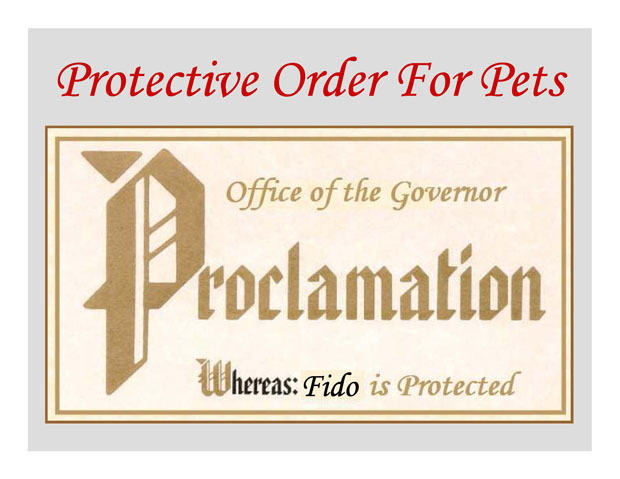
[Editor’s note: This article contains graphic images of animal negligence and abuse, which some may find disturbing. Reader discretion is advised.]
According to LA County deputy DA Deborah Knaan, it would be any dumb creature, and she wasn’t referring to your idiot neighbor who leaves his car in front of your garage.
“Animals are like infants and cannot defend themselves,” Knaan said. “They’re completely dependent on us to help them and stand up for them. And we also recognize that people who mistreat animals also mistreat people.”
It’s been over two months after the Animal Care and Cruelty-Prevention Conference, presented on March 21 by the Office of the Long Beach City Prosecutor and Animal Care Services (ACS) and held Thursday evening, March 21. Between trying to write a column in the face of work, other projects and general exhaustion, I put together three other standalone columns that were light in content. At the same time, the news was rife with disasters and tragedies local and worldwide, and it never seemed like the “right time” to post an article about animal cruelty.
But media reports also showed responses to these calamities by decent and caring people, and most of the people who read pet columns are also decent and caring. So, I’m not putting it off anymore, and none of it is time sensitive or “old news”—sadly. Even if you don’t live with a companion animal, read on and find out how you can be a voice for the voiceless.
One of Knaan’s job descriptions is animal cruelty case coordinator, heading an entire department devoted to prosecuting animal abusers. She’s the guru of animal cruelty, and we were fortunate to have sat at her feet this year and last and benefit from her expertise. The first animal case to be prosecuted in L.A. County was in 2007, and Knaan is satisfied that they can now prosecute cases based on collected evidence. She named the forms of animal cruelty: neglect; intentional; animal hoarding; organized abuse, aka bloodsports; ritualized abuse; and the disgusting (my words, but she no doubt was thinking it) acts of sexual assault of animals. What isn’t animal cruelty, Knaan said, includes not walking your dog, leaving your dog in the yard 24 hours a day (although she added that keeping an animal confined in an enclosed area without providing adequate exercise area is illegal and violates California Penal Code 597t), not interacting with your pet, and leaving any animal on the balcony. (And why get a pet if you’re going to ignore it?)
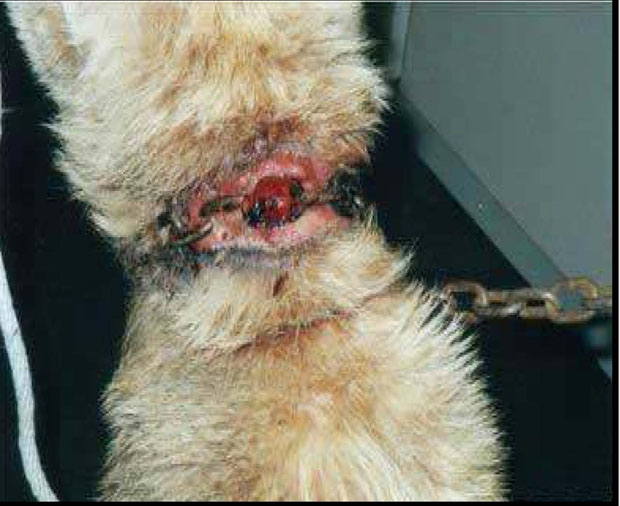
This is what happens when a dog’s collar isn’t adjusted.
Intentional cruelty comprises willful and intentional cruelty, cruelty by neglect and criminal neglect. For many of us, abuse of an animal is an atrocity, and the perpetrator should be raked across hot coals. For those who may also be disgusted by extreme cruelty to animals but feel that abuse to humans is worse, Knaan reminded attendees that these sickos abuse people as well. She cited the Night Stalker, Ted Bundy, Son of Sam, and Dylan Klebold and Eric Harris (the teenagers who carried out the Columbine shooting) as having previously committed cruel acts to animals. She cited one individual who beat his brother’s two dogs nearly to death; on a separate occasion, he whipped the snot out of an auto mechanic and fractured his eye socket over an argument about test-driving a car. Another person killed the family pets. If there’s anything that can be described as a silver lining to domestic abuse, Knaan stated that judges can now give a protective family order that includes pets.
Stopping these monstrous acts through identification, successful prosecution and therapy is imperative for both people and animals. Knaan says that if an intentional act of cruelty is witnessed, reported, and successfully reviewed, a charge of “causing or allowing unjustifiable suffering” is levied on the perpetrator. The maximum charge for a misdemeanor is one year in county jail and a felony earns three years maximum in prison (yeah, yeah, it isn’t enough, but it’s a start, and perhaps the other inmates won’t take kindly to bad people who hurt helpless pets).
Not all acts of cruelty toward animals are intentional. Neglect is the most common form of abuse, and Knaan says that over time it causes the most suffering. If the animal ultimately dies, it’s a long, slow, agonizing death. Neglect entails failing to provide for an animal for whose care a person is responsible. This includes placing an animal in a life-threatening situation, deprived of food, water, shelter, a vet or a combination of these necessities. If it’s reasonably foreseeable that harm would come to the animal through the neglect—or if it does come—it’s a criminal and bears consequences. For example, if a cat needs dental work and the owner doesn’t follow through, which results in the animal’s illness or death, it’s considered criminal neglect. Untreated ear infections, ingrown nails, grooming issues—if they endanger a pet’s life or well-being, all constitute neglect. Knaan illustrated her point with a photo of a dog with severe scabies, who was surrendered to a shelter and who later died.
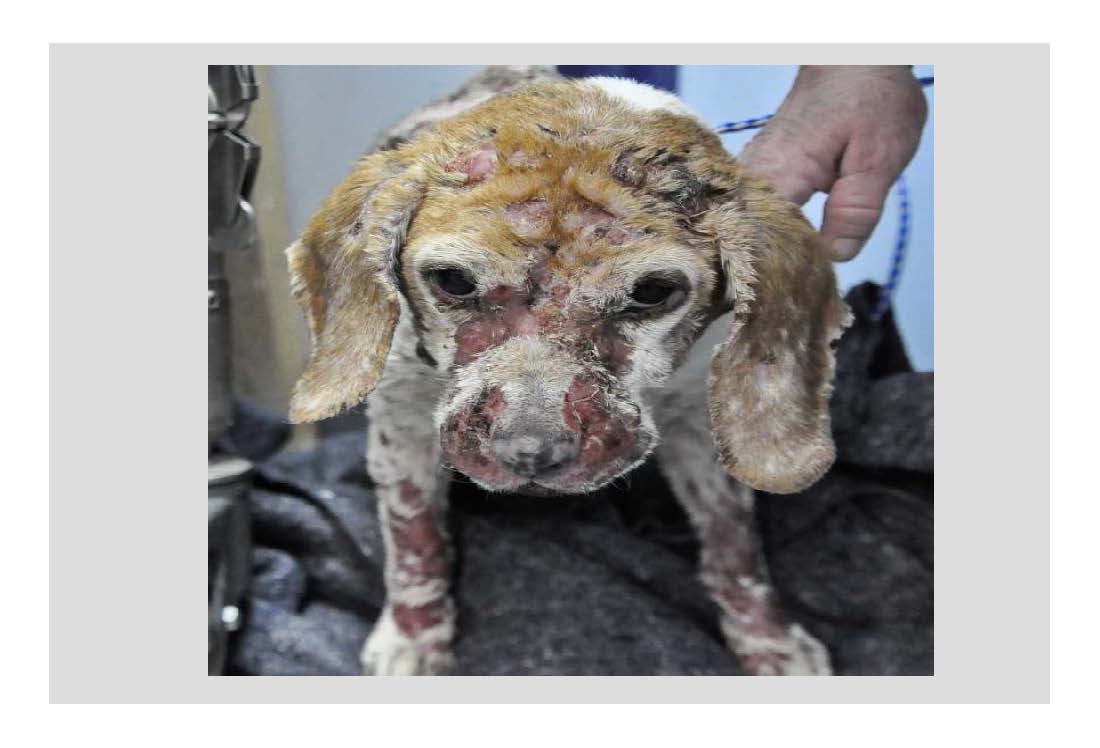
This puppy is a victim of severe neglect.
Tethering a dog is also neglect. Health and Safety Code 122335 prohibits tying a dog to a stationary object for more than three hours in a 24-hour period. Tethering, Knaan said, can cause aggression and could also present a choking hazard.
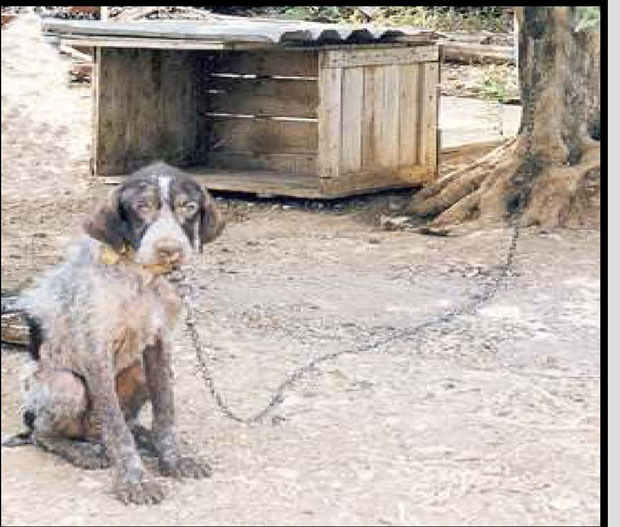
Hoarding is an unusual category in that hoarders see themselves as helping animals. It’s defined as the accumulation of an unusually large number of animals, neither providing minimal care for the pets nor acting on their deteriorating conditions. Even if the animals are in terrible shape, the hoarder is in denial over it and usually feels that he or she is saving them from the streets. Knaan believes that hoarding will eventually be classified as a mental illness, but even though the condition shows no malice or deliberate neglect—quite the opposite, in fact—it’s the four-footed pedestrians who walk the proverbial good intention-paved road to hell.
Dogfighting and cockfighting are classified as organized abuse. These aren’t sports but vicious activities in which two animals are set upon each other to fight to the death. If the “loser” isn’t killed in the fray, the owner may dispose of him or her. The fighting animals aren’t the only victims; perpetrators of dogfights may use “bait animals” such as kittens or rabbits for “training” by throwing the little creatures to the dogs to shred. Meds such as hormones and vitamin B12 are also fed to the fight animals. Knaan said that things to look for on properties suspected of hosting animal fights are treadmills that seem to be adjusted, a fighting pit, and weights to attach to the collars.
Under California Penal Code 597.5, conviction of owning, possessing, keeping, or training a dog with intent to fight; actual fighting of a dog; fighting dogs kept or trained on the premises; or aiding and abetting any of the above is punishable by up to three years in state prison and a maximumfine of $20,000. Under 597b, cockfighting is considered a misdemeanor and allowing or aiding and abetting it to take place on anyone’s property is punishable by a term of up to one year in county jail and a maximum $5,000 fine. Knaan said that the law has been extended to spectating or helping prepare for a fight, which is also a misdemeanor and punishable by up to six months in county jail and a maximum $1,000 fine.
I won’t go into animal sexual assault or ritualized abuse—after reading the previous descriptions, I wanted to spare us all. Use your imagination, if you can stand it.
One important detail that must be mentioned now that summer’s nearly upon us is that fact that it’s a violation of California’s penal code to leave an unattended animal in a vehicle if by doing so, the pet’s health or well-being is endangered. Such conditions include heat, cold, lack of adequate ventilation, lack of food or water, or any other circumstances in which it’s reasonably expected to cause suffering, disability or death, for example, tethering a dog to the sissy bar, which can cause strangulation if the pet attempts to jump into the front seat. A peace officer or animal control officer may take any steps necessary to get the animal out, including breaking into the car.
Knaan’s office provides posters and cards (see below) to leave on cars in which animals have been left unattended; they can be requested at DKnaan@da.lacounty.gov, but if the animal is in clear and present danger, try locating the owner by talking to the store manager and having him or her paged and notify security. The owner may choose to ignore the announcement; if there’s real danger, notify the police or animal control.
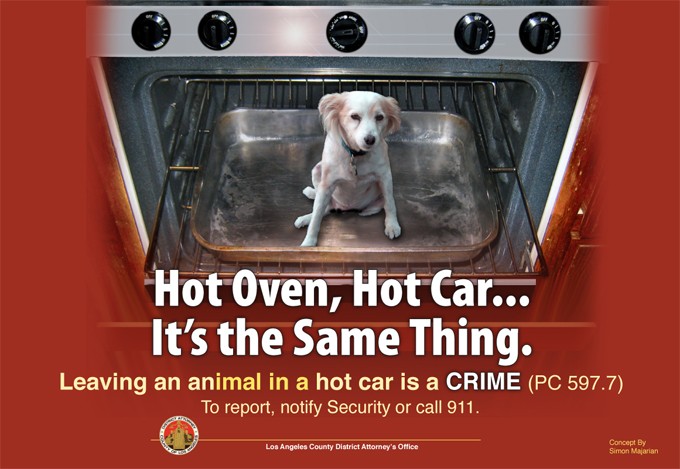
“It’s not even summer yet, and we’ve had a number of car-related deaths,” Knaan said.
It can be daunting or intimidating to be forthcoming with any information regarding suspected animal abuse. But if you decide to step forward, do report the case to animal control and the police, and take photos, if possible. Keep at it until the situation is investigated. The city attorney and the DA will review the case, which should include evidence, proof of all elements, witness statements and a veterinarian’s professional opinion. The case may merit further investigation, there may be an office hearing, or it may be declined altogether—but it also may be successfully prosecuted and, it is hoped, the animal may get a better home.
Whatever you do, don’t remove the animals yourself, clean up, or provide food, much as you’ll be tempted to. If the animal’s at death’s door, of course, give water, but let the authorities know that you did. In order to file a criminal case, all conditions provide evidence and proof of elements of abuse.
As I’ve previously stated, I wish more children had been present at this conference. But if you’ve read this long article in its entirety, chances are you’re an animal advocate. Pass this education on to any children in your life. “Be kind to animals” casts an ever-widening net.
View Parts 1 and 2 of the conference if you could not attend.
“Think occasionally of the suffering of which you spare yourself the sight.”
~ Albert Schweitzer
Virtually Pets
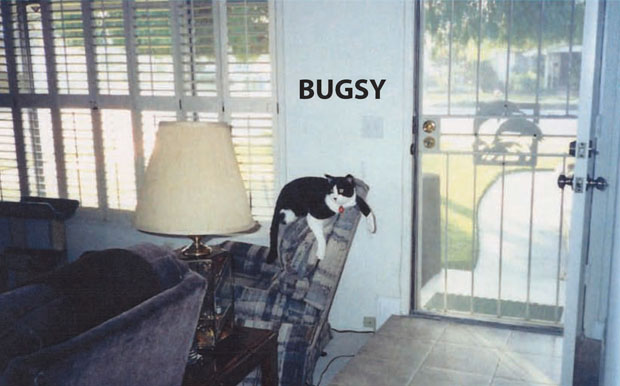
Bugsy is a 16-pound tuxedo, 11 years old. He will play if interacted with and can be very loving, although he’s shy around strangers. He needs a quiet home with no dogs or young children. His owner can no longer have a cat because of a severe allergic reaction for which she is hospitalized and needs to find a home for him or have him euthanized. This is a sorry idea for someone who has been a loving, loyal friend for over a decade. If you or someone you know can take Bugsy, please contact sdcain31@cox.net or denise4re@gmail.com.
Pet Projects
Remember the survivors of the Oklahoma, tornado tragedy. As you do, don’t forget the pets who are being sought by their human families or are lost and frightened. Go to the Humane Society of the United States Disaster Relief Page.

Saturday, June 8, Fix Long Beach’s Free Spay/Neuter Clinic Inaugural Event, Orizaba Park, 1435 Orizaba Ave between 14th and Spaulding streets, 10:30AM. (Appointment times will vary for patients)
This is Fix Long Beach’s first ever FREE mobile spay-and-neuter clinic! FLB is looking for volunteers to hand out information, assist at tables, and help with the flow of the event. We will have a DJ, sample/gift tables, information stations and much more! FLB ask that all volunteers wear a Fix Long Beach T-shirt, which will be provided at the event and which will be worn at all future events. The cost of each T-shirt is $5, which will go right back into the promotional budget! The organization would like to keep track of how many people are volunteering, as they’re bringing Fix Long Beach T-shirts for everyone. More door-to-door events will be happening, and another spay/neuter clinic will be held on June 22 at Bixby Park, 2001 E. First St., from 11AM–4PM. Click here to volunteer. Visit Fix Long Beach’s Facebook page to find out about future events.
Saturday, June 8, Heidi and Frank Pet Adoption Day, spcaLA at Pitchford Companion Animal Village, 7700 E. Spring St., Long Beach, 10AM–4PM.
Enjoy a day with KLOS 95.5 edgy airwaves duo Heidi Hamilton and Frank Kramer as they strongly encourage you to take home one of spcaLA’s wonderful pets. Enjoy vendor booths, refreshments, silent auctions and of course, meeting the animals.
Saturday, June 15, spcaLA Mobile Adoption Event, PetSmart at Long Beach Towne Center, 2631 Carson Blvd., Long Beach, 10:30AM–3:30PM
Don’t want to go to spcaLA to adopt? Shelters put you off? They’ll come to you! Meet a potential new family member and best friend forever! Click here for more information.


